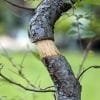When growers have a bonsai tree with desirable characteristics, they may be interested in using a cutting method to create multiple trees with the same features as their favorite bonsai. Cuttings will allow them to do just that.
Additionally, the cutting procedure is faster than seed growth in creating a bonsai tree. Furthermore, growers may have a tree species that will make trees with healthy roots quicker than some species can sprout initial growth.
Cutting involves taking branches from a healthy tree and placing it into soil to create a new tree. Additionally, the cutting method is the most popular for bonsai tree developers and is one that will create high quality trees.
The reason most bonsai gardeners use the cutting method is that the new tree will retain the positive features from the parent tree.
In some cases, the leaves of bonsai trees may begin to dwarf or mutate, and when this occurs, the branches can be planted to create another beautiful tree without the leaf mutation.
Also, gardeners have the opportunity of creating a twin or triple trunk bonsai when planting multiple pronged branches.
An added benefit to the cutting method is the ability to correct the tree’s growth. Young bonsai trees can be encouraged to grow straight with consistent trimming.
Also, the best time for growers to use the cutting method is during the spring. The procedure is simple, but several tips will aid in a grower’s success.
Growers should always plant cuttings in new soil. Also, the dirt should be rinsed to remove organic chemicals since additional nutrients can cause the roots to rot.
The soil should be moistened prior to planting the tree.
Furthermore, during the cutting process, the gardener should remove the branch with sharp scissors, which will ensure that the cross section receives a clean cut.
The grower should trim most of the leaves from the branch, which will prevent water shortage to the main branch and roots. Also, the branch should be soaked in water for up to one hour for optimal water absorption.
When using the cutting method to create trees, gardeners should remember that:
- Cuttings produce trees quickly
- The cutting method ensures positive tree features
- Cuttings are successful when they are planted in properly moistened new soil
- The cut should be precise
- Patience is required


